The Pelagic Thresher Shark is the smallest species among all the thresher sharks. It’s easily recognized by its long, thresher-like tail, which can be as long as its body. The shark inhabits tropical waters around the globe, particularly near coral reefs, where it uses its powerful tail to stun prey with a single slap.
In addition to their impressive tails, these sharks have many other interesting characteristics that make them unique. From their anatomy and diet to some fun facts about this species, here is an overview of everything you need to know about the Pelagic Thresher Shark.
About: Pelagic Thresher Sharks
Pelagic Thresher Sharks, scientifically known as Alopias pelagicus, are a species of shark within the family of Alopiidae. Generally, these sharks are considered harmless to humans and typically only grow to around 10 feet in length. However, some individuals have been recorded at sizes nearly twice this long.
These amazing creatures inhabit deep offshore waters across the world in pelagic habitats, creating ideal conditions for them to hunt small fish and squid using their long thresher-like tail fin.
Pelagic Thresher Sharks are silver on top and light gray on the bottom, with a unique stripes pattern along either side for added camouflage. Despite their immense size, these sharks pose little danger to humans as they prefer skittish prey like smaller fish, which they can easily spot using sight and electro-reception organs around their mouths and snouts.
Here is a chart given below to have an idea about the pelagic thresher sharks:
| Category | Information |
| Kingdom | Animalia |
| Phylum | Chordata |
| Class | Chondrichthyes |
| Order | Lamniformes |
| Family | Alopiidae |
| Genus | Alopias |
| Species | Alopias pelagicus |
| Common Name | Pelagic Thresher Shark |
| Habitat | Pelagic waters of tropical and temperate oceans, typically found near continental shelves and seamounts |
| Diet | Small fish, squid, and pelagic crustaceans |
| Average length | 3-4 meters (9.8-13.1 feet) |
| Average weight | 150-160 kg (330-350 lbs) |
| Average lifespan | 29 years |
| Physical Description | Blue-gray back, light blue-gray sides, and a white underbelly- Torpedo-shaped body with big eyes and a small, downturned mouth-Possesses a whip-like tail that can be longer than its body |
| Behavior | Pelagic threshers are known for their acrobatic leaps out of the water- They use their whip-like tail to stun and immobilize prey before eating it |
| Reproduction | Ovoviviparous reproduction, giving birth to live young after a gestation period of about 9 months- Give birth only 2 pups at a time |
| Conservation Status | Near Threatened (IUCN Red List) |
| Threats | Overfishing and bycatch in commercial fisheries- Habitat destruction and pollution |
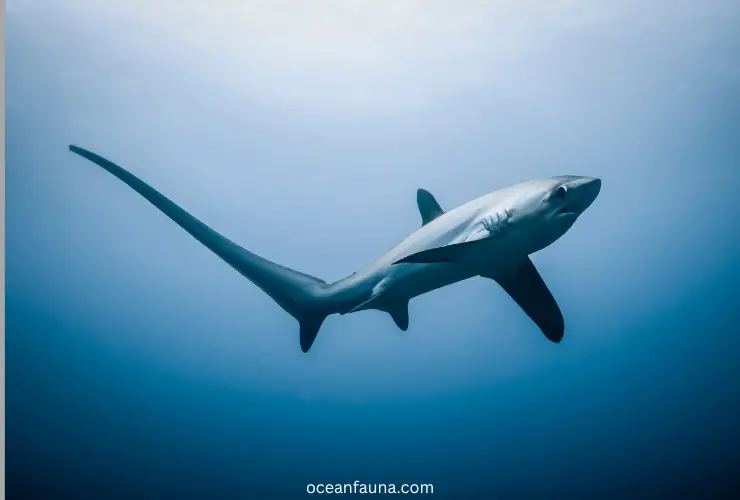
Fun Facts about Pelagic Thresher Sharks
Whip-like tail
While other sharks are known for razor-sharp teeth and predation, pelagic thresher sharks are distinguished by their long, whip-like tail that can be up to half the length of their body.
Camouflage
Pelagic thresher sharks have a unique dark-blue back and a white underside, helping them blend into the environment when seen from above and below.
Streamlined shap
The slender body of pelagic threshers helps them move quickly through the open ocean, allowing them to escape predators or pursue prey efficiently.
Birth only two pups
Female pelagic threshers give birth to only two pups at a time, making them particularly vulnerable to overfishing.
Primarily nocturnal
Pelagic thresher sharks are primarily active and feed during the night, seeking cover in deeper waters during the day. This is likely due to their sensitivity to ultraviolet light, which can damage their skin.
Detailed Discussion on Pelagic Thresher Sharks
From the chart, you already know about pelagic sharks, including their appearance, family, habitat, diet, threats, and others. Now, I will tell you something more that you may not know.
Anatomy of Pelagic Thresher Sharks
General Structure
Pelagic thresher sharks, scientifically known as Alopias pelagicus, are large predatory fish found in tropical and subtropical oceans worldwide. These sharks have an impressive size range from 3-4 meters (9.8-13.1 feet) in length, depending on the sex of the shark.
They have slender bodies with elongated tail fins, which makes them instantly recognizable by their silhouette. Their skin coloration varies from grayish blue to brown and white underneath, with darker spots and stripes along their sides. Along with this general structure, several organs make up these fascinating creatures.
Skeletal System
The skeletal system of a pelagic thresher shark consists mainly of a cartilaginous skeleton, which allows for more flexibility when swimming. The skull comprises two large pieces, and the backbone comprises between 28-33 vertebrae. The pectoral fins are long, narrow, and pointed, and their tail fin is incredibly powerful with a characteristic thresher-like shape.
Muscular System
A pelagic thresher shark’s muscular system comprises multiple sizable muscles that give it strength for swimming and snatching prey.
There are two dorsal fins on its back: a triangular upper fin near the base of its caudal fin that aids in steering while swimming and a crescent-shaped lower fin around its midsection that aids in stabilizing it when turning quickly or moving suddenly within water columns.
Moreover, the fish has four pectoral fins on each side near its head that help it move more powerfully and change direction quickly when it spins or is pursuing prey items.
Circulatory System
These creatures’ circulatory systems play a crucial part in ensuring that their internal processes run smoothly, enabling them to carry out essential tasks like respiration and digestion during feeding behaviors or movement through various environments while hunting or looking for safety from predators.
Compared to other fish species found in similar environments with similar sizes or diets, pelagic thresher sharks typically reach ages up to 29.
This complex network is made up primarily of three main parts: arteries, veins, and capillaries. It transports oxygenated blood through the body’s organs and helps move nutrients where needed while keeping waste materials away from vital areas within their bodies.
Respiratory System
The respiratory system comprises two sets of gills, allowing these organisms to take oxygen from their environment into their bloodstream via diffusion at an impressive rate because of their high metabolic rates, made possible by the large amounts of energy consumed daily.
Despite only consuming food once every 10 days because of the size of large meals they typically consume during hunting bouts, these organisms are among the most active predators within oceanic ecosystems around the world.
Removing carbon dioxide from the bloodstream also enables them to carry out their tasks without depleting their energy reserves, allowing them to recover after prolonged activity before going out hunting again.
Nervous System
The nervous system sends signals to all body parts and coordinates voluntary muscle control during movement through water columns and reflexive responses like fear responses that protect against potential threats lurking nearby.
It lets these creatures stay ahead of any dangers they might encounter while hunting or just moving around the ocean environment they live in. This complex network is also home to organs like the shark’s eyes and optic lobes, which give these sharks very sharp binocular vision.
It allows them to see even the smallest movements that happen far away, so they can run away from a potential predator or take advantage of an opportunity to chase prey further away.
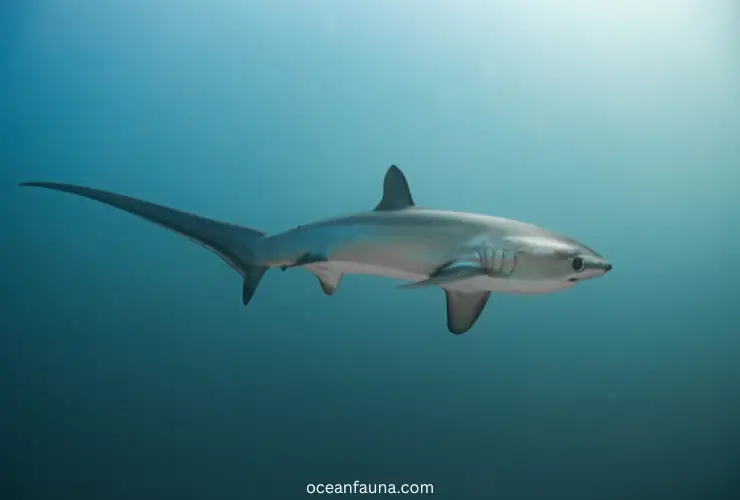
What Do Pelagic Thresher Sharks Eat?
Pelagic thresher sharks typically feed on a variety of smaller fish, such as anchovies, herring, bluefish, juvenile tuna, mackerel, and sardines. They also hunt squid and occasionally other species of shark.
They use their long tails to stun or injure prey, making catching them easier. Pelagic threshers have been observed eating tuna in the wild, suggesting they may feed on larger prey when the opportunity arises.
Pelagic thresher sharks are ambush predators using camouflage to blend into the open-ocean environment. They can be found as far as 2000 meters below the ocean’s surface during nighttime hunting hours and work their way back up toward the top of the water column during daytime hours. Studies suggest that they are solitary hunters during much of these times and prefer to hunt alone.
The feeding behavior of pelagic thresher sharks has been studied in detail using tagged sharks that were monitored over long periods in different regions around the world.
These studies revealed that this species mainly feeds at depths between 200-500 meters, and hunting efforts become more concentrated near seamounts (underwater mountains) and other areas where deep-sea currents converge, bringing with them a greater abundance of prey fish.
In addition to its diet consisting mainly of fish, it appears that the pelagic thresher shark also enjoys scavenging from carcasses, including whale and dolphin carcasses, but there is still much more research needed to confirm this behavior on a broader scale. A recent study found that pelagic threshers eat plastic trash.
It means that scientists should look more closely at how human activities may affect the diet and health of this species over time.
Where Do Pelagic Thresher Sharks Inhibit?
Pelagic Thresher Sharks (Alopias pelagicus) are highly migratory sharks that inhabit the ocean’s upper layers. These open-water predators are found in scattered regions around the globe, primarily in tropical and temperate waters.
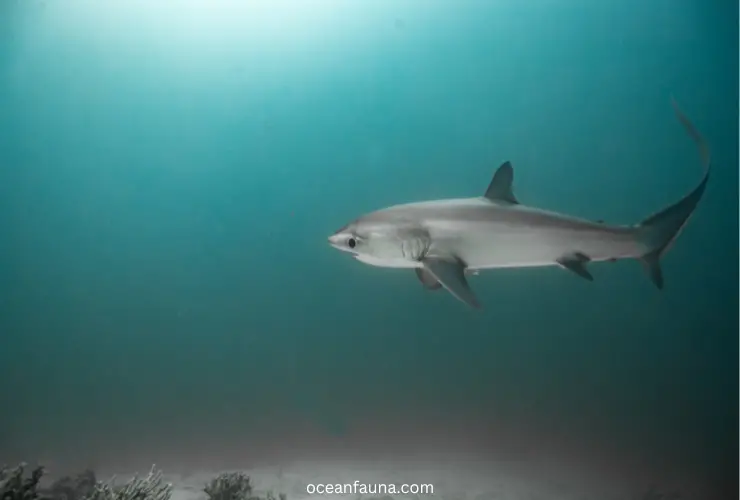
They can be found in the Atlantic, Indian, and Pacific Oceans, ranging from as far north as Massachusetts and South Africa to southern Chile and New Zealand.
Pelagic Thresher Sharks occupy a wide variety of marine habitats, but they share a preference for warm water temperatures and strong ocean currents.
In the Northern Hemisphere, they are most common in the Mediterranean Sea and off the coasts of California, Hawaii, and Japan. The majority of their global presence is concentrated in the central Indian Ocean between Oman and Sri Lanka.
Within these areas, Pelagic Thresher Sharks inhabit coastal shelves, seamounts, island chains, reefs, deep channels, and other structures at depths ranging from near-surface waters to over 500 meters (1,640 feet). They can often be found swimming around fishing boats or spending time inside estuaries or bays where food sources are abundant.
During certain times of the year, Pelagic Thresher Sharks may form large aggregations out at sea to feed on schooling fish such as sardines or anchovies; these gatherings sometimes occur during annual spawning events when food resources become abundant.
Additionally, these sharks will migrate long distances to take advantage of seasonal prey availability. These migratory routes often take them through narrow underwater canyons, which act as natural highways for many pelagic fish species, including tuna and wahoo.
Despite having an extensive range in tropical areas worldwide, Pelagic Thresher Sharks remain largely unstudied due to their open ocean lifestyle, which makes them difficult to track. However, recent tagging experiments have provided valuable insight into their movement patterns throughout different parts of their range.
How Do Pelagic Thresher Sharks Reproduce?
Pelagic thresher sharks are ovoviviparous and reproduce via internal fertilization. During mating, the male shark inserts his claspers into the female’s oviduct and releases sperm to fertilize her eggs.
After mating, the female stores the sperm in her body until she is ready to lay her eggs. When she is ready to give birth, she lays two large pups at a time in an egg case that has been constructed from sturdy materials, including cartilage and skin secretions.
Each pup remains within the egg case for several months before it hatches and begins its independent life as a pelagic thresher shark.
Unlike other ovoviviparous species, such as some skates and rays, pelagic thresher sharks do not form any kind of placenta or attachment with their young during gestation. The female does not nourish the embryo in any way.
Instead, the embryos rely on stored yolk within their egg cases for nutrients. Once they hatch, they are able to fend for themselves in open waters with no assistance from their mothers.
During mating season, males will often compete aggressively with one another to gain access to females by slamming their tails into one another or chasing each other away from potential mates. Mating typically occurs shortly after this competition. It usually takes place in shallow coastal waters near abundant food sources.
Reproduction can be quite risky for pelagic threshers due to their relatively small population numbers and slow reproductive cycle. Female pelagic threshers don’t reach their sexual maturity until they are between 13-14 years old.
Once they become sexually mature, they can mate every three to five years but have limited offspring throughout their lifetime because they only give birth to two pups at a time.
How Long Do Pelagic Thresher Sharks Live?
Pelagic thresher sharks are a species of thresher shark found in the open ocean. They are known for their long, whip-like tail that they use to stun and disorient prey. The average lifespan of a pelagic thresher shark is 29 years.
However, some reports say it can vary significantly depending on their environment and other factors. Depending upon the habitat and environment, thresher sharks may live around 14-16 years.
Threshers are slow-growing sharks, with males reaching maturity at around 8-9 years old and females reaching maturity at 13-14 years old. Female pelagic threshers also have longer lifespans than males, estimated at around 16 years compared to 14 years for males.
This is likely due to differences in growth rate, with females taking longer to reach maturity and thus having more time for growth.
In addition to age, environmental factors such as water temperature, salinity, and food availability can also influence the longevity of these sharks.
For example, threshers living in cooler waters may face colder temperatures that reduce metabolic rates and energy needs. This could lead them to live longer than those living in warmer waters where metabolism would increase.
Similarly, areas with higher food availability may provide more nutrients, leading to greater longevity than areas with lower food availability.
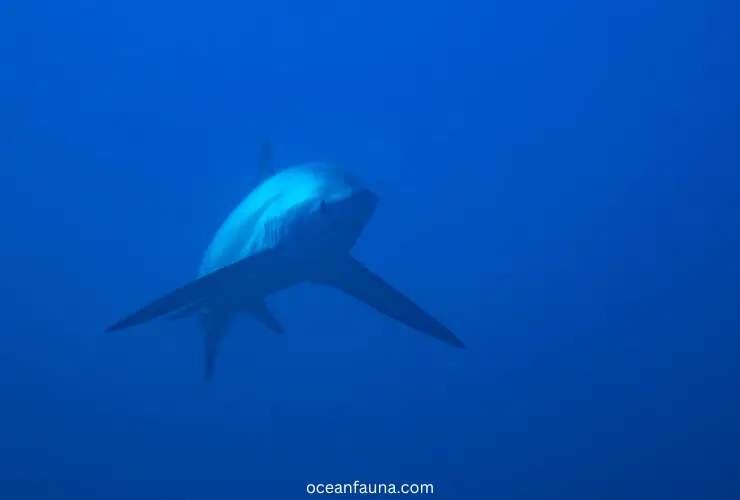
Threats and Cautions: Save Pelagic Thresher Sharks
The pelagic thresher shark is threatened by several factors, with fishing being the biggest threat to its survival. The long caudal fin that this species possesses makes it highly vulnerable to bycatch in tuna fisheries and targeted fisheries.
Longline fisheries involving the large-scale deployment of baited hooks can inadvertently capture the sharks and cause mortality due to entanglement or drowning if they cannot escape.
Baitfish fleets also target pelagic thresher sharks as they cruise near the surface and are relatively easy to catch. These activities, combined with illegal and unregulated fishing operations, have significantly impacted their populations worldwide.
Habitat destruction and pollution also pose threats to the species. As shallow coastal waters are essential breeding habitats for many pelagic thresher shark populations, these areas are often subject to development, destroying the habitat and disrupting the food chain necessary for survival.
In addition, pollution from runoff, wastewater discharge and other sources can contaminate their habitats with heavy metals, organic contaminants and other pollutants, affecting the health of individual sharks and entire populations.
Overfishing of prey species such as small fish and squid can further threaten an already affected ecosystem by reducing food availability for predators like the pelagic thresher shark.
So to save them from extinction, We have to protect their habitats and reduce fishing pressure. Strict regulations should be imposed on fisheries, and conservation efforts should focus on establishing protected areas to help maintain existing populations of pelagic thresher sharks.
In addition, more research needs to be conducted into the ecology of this species so that we can better understand their biology and help ensure their long-term survival.
Conclusion
So, in this article, I have provided a compact knowledge of pelagic thresher sharks, including their physical features, behavior, and threats.
To guarantee their survival, we have to guard and maintain the natural habitats of these species as well as reduce fishing pressure.

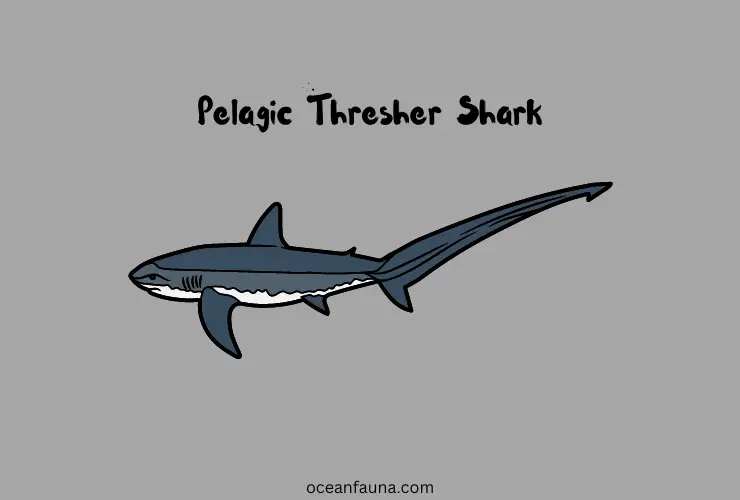
4 thoughts on “Pelagic Thresher Shark: Habitat, Diet, Anatomy & Fun Facts”